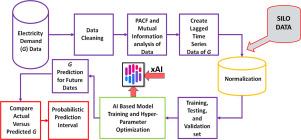可解释的深度融合网电力需求预测模型:将气候预测因素考虑在内,利用概率置信区间和基于点的预测实现准确性和更深入的洞察力
IF 10.1
1区 工程技术
Q1 ENERGY & FUELS
引用次数: 0
摘要
受能源市场波动的影响,电力消费具有随机变化性。能够捕捉到随机变化和不确定性的电力需求预测能力对于国家电力市场的规划、运营和监管具有重要意义。本研究提出了一种可解释的深度融合网电力需求预测模型,该模型将基于气候的预测因素考虑在内,以提高准确性和能源市场洞察分析,生成基于点和置信区间的每日电力需求预测。所提出的混合方法采用了深度融合网络(FNET),该网络由卷积神经网络(CNN)和具有残差连接的双向长短期记忆(BILSTM)网络组成。这项研究随后提出了一种新的深度融合模型,该模型整合了基础网络的中间表征(融合输出是每个基础网络剩余部分的输入),在多个中间表征上深度执行这些组合,以增强需求预测。结果通过预测和观测电力需求的统计指标和图形表示进行评估,并与独立模型(即 BILSTM、LSTMCNN、深度神经网络、多层感知器、多元自适应回归样条线、核岭回归和高斯回归过程)进行比较。拟议 FNET 模型的末端部分采用了残差引导法,即通过预测需求和观测需求计算最终残差,生成 95% 的预测区间,并使用概率指标进行分析,以量化与 FNETS 目标模型相关的不确定性。为了提高 FNET 模型的透明度,采用了 SHapley 加法解释(SHAP)方法来阐明电力需求与基于气候的预测变量之间的关系。建议的模型分析表明,前一小时的电力需求和蒸发蒸腾作用是对当前电力需求产生积极影响的最大影响因素。这些发现强调了 FNET 模型能够产生准确而有洞察力的预测结果,从而证明了该模型在预测电力需求和分析能源市场决策方面的实用性。本文章由计算机程序翻译,如有差异,请以英文原文为准。

Explainable deeply-fused nets electricity demand prediction model: Factoring climate predictors for accuracy and deeper insights with probabilistic confidence interval and point-based forecasts
Electricity consumption has stochastic variabilities driven by the energy market volatility. The capability to predict electricity demand that captures stochastic variances and uncertainties is significantly important in the planning, operation and regulation of national electricity markets. This study has proposed an explainable deeply-fused nets electricity demand prediction model that factors in the climate-based predictors for enhanced accuracy and energy market insight analysis, generating point-based and confidence interval predictions of daily electricity demand. The proposed hybrid approach is built using Deeply Fused Nets (FNET) that comprises of Convolutional Neural Network (CNN) and Bidirectional Long-Short Term Memory (BILSTM) Network with residual connection. The study then contributes to a new deep fusion model that integrates intermediate representations of the base networks (fused output being the input of the remaining part of each base network) to perform these combinations deeply over several intermediate representations to enhance the demand predictions. The results are evaluated with statistical metrics and graphical representations of predicted and observed electricity demand, benchmarked with standalone models i.e., BILSTM, LSTMCNN, deep neural network, multi-layer perceptron, multivariate adaptive regression spline, kernel ridge regression and Gaussian process of regression. The end part of the proposed FNET model applies residual bootstrapping where final residuals are computed from predicted and observed demand to generate the 95% prediction intervals, analysed using probabilistic metrics to quantify the uncertainty associated with FNETS objective model. To enhance the FNET model’s transparency, the SHapley Additive explanation (SHAP) method has been applied to elucidate the relationships between electricity demand and climate-based predictor variables. The suggested model analysis reveals that the preceding hour’s electricity demand and evapotranspiration were the most influential factors that positively impacting current electricity demand. These findings underscore the FNET model’s capacity to yield accurate and insightful predictions, advocating its utility in predicting electricity demand and analysis of energy markets for decision-making.
求助全文
通过发布文献求助,成功后即可免费获取论文全文。
去求助
来源期刊

Applied Energy
工程技术-工程:化工
CiteScore
21.20
自引率
10.70%
发文量
1830
审稿时长
41 days
期刊介绍:
Applied Energy serves as a platform for sharing innovations, research, development, and demonstrations in energy conversion, conservation, and sustainable energy systems. The journal covers topics such as optimal energy resource use, environmental pollutant mitigation, and energy process analysis. It welcomes original papers, review articles, technical notes, and letters to the editor. Authors are encouraged to submit manuscripts that bridge the gap between research, development, and implementation. The journal addresses a wide spectrum of topics, including fossil and renewable energy technologies, energy economics, and environmental impacts. Applied Energy also explores modeling and forecasting, conservation strategies, and the social and economic implications of energy policies, including climate change mitigation. It is complemented by the open-access journal Advances in Applied Energy.
 求助内容:
求助内容: 应助结果提醒方式:
应助结果提醒方式:


